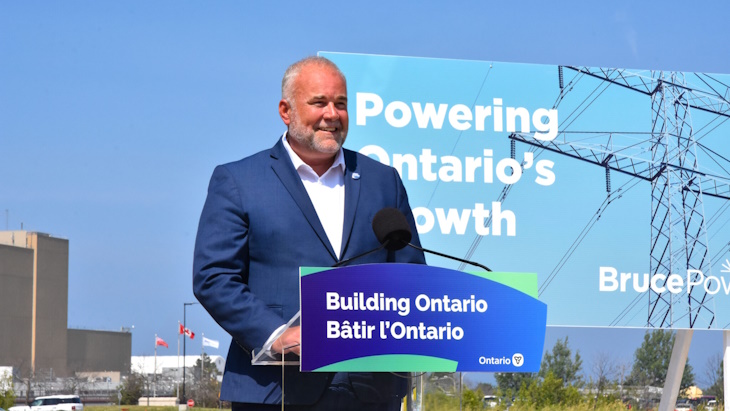
Electricity demand in Ontario is rising for the first time since 2005, the government said. It has already implemented a plan to meet rising demand in the current decade, but Ontario's Independent Electricity System Operator (IESO) last year issued a report forecasting that the province could need to more than double its electricity generation capacity from today's 42,000 MWe to 88,000 MWe by 2050.
The IESO report recommended that Ontario begin planning, siting and environmental assessment work for long-lead assets, including nuclear power, as a "no regret" action towards meeting decarbonisation goals and increasing electricity demand driven by strong economic growth, electrification and population growth beyond 2030.
Bruce Power's eight existing Candu reactors already produce some 30% of Ontario's electricity, and the company said the site has space for "incremental infrastructure development". President and CEO Mike Rencheck said nuclear power had been the "stable backbone" of Ontario's electricity system for decades, and the long-term planning and consultation activities will determine how it can further contribute to Ontario's clean energy and economic development goals. The long-term planning and consultation activities will not impact the company's ongoing programme to secure the site's operation until 2064.
Minister of Energy Todd Smith said Ontario's "open for business approach" has led to "unprecedented" investments across the province. "With our plan already in place to meet demand this decade, we are starting the pre-development work to identify future generation options, including reliable, affordable and clean nuclear energy, that will power our province into the future," he said.
The process for approving and building new nuclear capacity could take a decade or longer, and federal approval is the first step in this process, the government said. The pre-development work will take several years to complete and will help evaluate the suitability of the site by examining the impacts of a new facility on the environment, the public and Indigenous communities, with significant public input and community consultations. It is also a prerequisite for the Canadian Nuclear Safety Commission's licensing process for a new large-scale reactor.
The Ministry of Energy said it is working with the IESO and Bruce Power on a contractual approach to address the costs associated with the pre-development work to minimise the impact on ratepayers and will also look for ways to use funds collected from the sale of clean energy credits through the Future Clean Electricity Fund to help reduce the costs for ratepayers.
Eighteen of Canada's 19 operating Candu reactors are in Ontario, where they provide around half the province's electricity. Although nuclear capacity played a key role in enabling the province to entirely phase out coal-fired electricity generation in 2014, plans for new large-scale reactors had been shelved in favour of projects by Bruce and Ontario Power Generation (OPG) to refurbish existing reactors to allow them to continue operating well beyond the middle of the century. The province is also - alongside Alberta, New Brunswick and Saskatchewan - pursuing a strategic plan to develop and deploy small modular reactors (SMRs), and OPG has begun site preparation for a grid-scale SMR at a site adjacent to its existing Darlington plant.
"Ontario's electricity system is already cleaner than California or Germany and the Bruce Power nuclear site was instrumental in helping to phase out coal and establishing Ontario's clean energy advantage," Dave Butters, president of the Association of Power Producers of Ontario, said. "Today's announcement to identify future generation options to meet rising electricity demand creates a tremendous option for the province both to meet our coming power needs, and support our transition to net-zero."
Bruce Power is located in the traditional and treaty territory of the Saugeen Ojibway Nation and the harvesting territories of the Métis Nation of Ontario and the Historic Saugeen Métis.